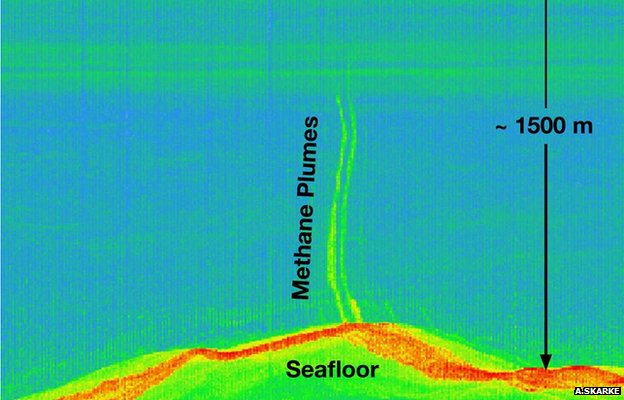
西北海岸的甲烷羽流散发
Methane Plumes Bubbling Along Northwest Coast
西北海岸的甲烷羽流散发
Researchers report a spike in the number of methane plumes along the Northwest coast emanating from depths of about 500 meters, a possible indication that submerged frozen methane is becoming available.
研究者指出,在美国的西北海岸,越来越多的甲烷从离水面500米海底泄漏出来。这可能意味着埋藏在海底的冰冻甲烷可能可以被利用了。
撰文/播音 Julia Rosen
翻译 M
审稿 邰伦玥
The Northwest is famous for its microbrews. But the region’s bubbles aren’t just for beer. Scientists have found plumes of the potent greenhouse gas methane bubbling up from the seafloor off the coast of Oregon, Washington and British Columbia.
美国的西北地区以精酿啤酒闻名。然而,在这个地区冒泡泡的不单是啤酒。科学家发现,源源不断的强效温室气体——甲烷从俄勒冈、华盛顿与不列颠哥伦比亚海底咕嘟咕嘟地冒出来。
The methane comes from rotting organicmatter, that is, the waste and dead bodies of land and marine organisms. “They fall into the sediments and they decompose. It’s like a compost pile.” Paul Johnson, a marine geologist at the University of Washington.
这些甲烷来源于腐化的有机体,即陆地与海洋生物的排泄物与腐败的尸体。“这些有机物沉积到海底并开始分解。就像堆肥一样。”保尔·约翰孙,来自华盛顿大学的海洋地理学家如是说。
Methane leaks out of this great compost pile all along the continental margin. But Johnson says some plumes may originate in vast layers of frozen methane called hydrates. Scientists worry that rising ocean temperatures may destabilize these deposits, freeing up even more methane. And Johnson thinks he already sees evidence that it’s happening.
甲烷就是从大陆边沿大量的堆肥中逸散出来的。然而约翰孙认为,一部分的甲烷释放可能来源于海底下大量的甲烷水合物——一种被冰冻的甲烷。科学家担心海洋温度的上升可能使这些冰冻物不稳定,从而释放更多的甲烷。而约翰孙认为他已经找到这正在发生的证据。
Over the past few years, Johnson’s team compiled a map of more than a hundred Northwest methane seeps. In a new study in the journal Geochemistry, Geophysics, Geosystems, the researchers report a spike in the number of plumes emanating from depths of about 500 meters. [H. Paul Johnson et al, Analysis of bubble plume distributions to evaluate methane hydrate decomposition on the continental slope]
在过去的几年,约翰孙的团队绘制了西北海岸的数百个甲烷泄漏所在地的地图。发表在《地球化学、地球物理与地理系统》上的一项研究显示,研究者发现越来越多的甲烷从离水面500米海底泄漏出来。
That’s the shallowest depth where frozen methane is stable—and the first place scientists expect it to start bubbling out.
水深500米是冰冻甲烷能稳定的最低深度——而科学家认为该深度的甲烷将会首先开始冒出水面。
But Johnson says we’re not facing a climate catastrophe just yet. Most of the methane released at the seafloor gets consumed by bacteria before it can escape into the atmosphere. Unfortunately, that’s still bad news for Northwest ecosystems. When bacteria feast on methane, they also consume precious oxygen and produce carbon dioxide—which makes seawater more acidic.
但是约翰孙认为我们现在面对的还不是一次气候大灾难。大部分的甲烷在逸散到大气之前就被海洋中的微生物吸收了。不幸的是,甲烷散发仍然损害着西北海岸的生态系统。当微生物吸收甲烷时,他们同样消耗着海水中珍贵的氧气,并释放出二氧化碳,后者使海水酸化。
“We have a bad problem out here with ocean acidification and anoxia. There are fish kills along the Oregon coast and now they are spreading up here along the Washington coast. This is making that problem worse.”
“我们的问题就是海水酸化和缺氧。沿着俄勒冈州的海岸已经有鱼群死亡,并且这种现象已经扩散到了华盛顿海岸,这些都加剧了酸化与缺氧的问题。”
After all, these hydrates seem to be belching out lots of gas.
毕竟,这些水合物貌似喷发出了大量甲烷。
“And we calculated that the amount of methane that’s released from this hydrate decomposition is equivalent to the Deep Horizons spill in the Gulf of Mexico, every year.”
“我们计算了水合物分解所释放的甲烷的量,与墨西哥湾深水地平线油井每年的泄漏的量相当。”
As warming continues, Johnson says that figure could increase by a factor of four or five. In short, the bubbly waters of the Northwest won’t go flat anytime soon.
伴随着全球持续变暖,约翰孙认为泄漏量的数字会上升到4或5倍。短期内,西北海岸的冒泡并不会停止。
(题图来源:polyconundrum.com)
未经书面许可任何人不得复制或镜像
京ICP备11000850号
 京公网安备11010502039775号
京公网安备11010502039775号 信息网络传播视听节目许可证0111611号
国家科技基础条件平台

















